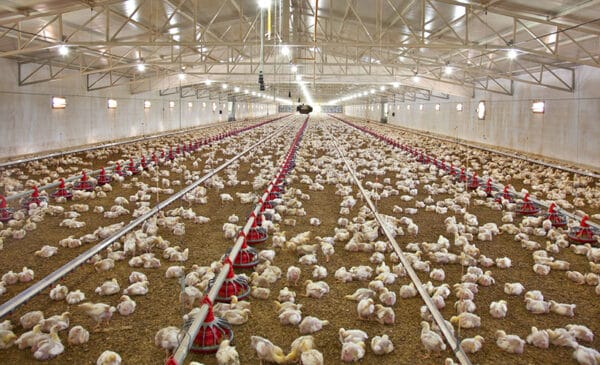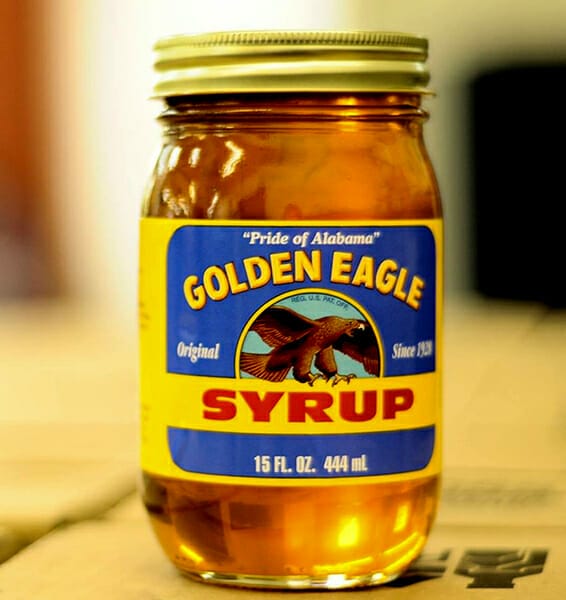Food Production in Alabama
 Broiler Chicken House
The food products sector in Alabama includes crop and animal production and food products manufacturing. The dollar value of Alabama crop and animal products sold in 2017 was $5.98 billion, accounting for approximately 3.1 percent of the state’s real gross domestic product (GDP) for that year. GDP is defined as the total value of goods and services produced in the economy. The food products manufacturing industry’s share of Alabama GDP (ALGDP) has decreased from 2.0 percent in 1990 to less than 1.3 percent as of 2017, while employment in the food products manufacturing industry has increased from 27,200 in 1970 to approximately 33,000 in 2018, showing no growth over the previous ten years. (Manufacturing in the state has been on an upward trend since the 2008 recession, led in part by motor vehicles and parts.) The number of workers in animal slaughtering and processing has decreased from more than 19,000 in 1990 to fewer than 15,000 in 2019.
Broiler Chicken House
The food products sector in Alabama includes crop and animal production and food products manufacturing. The dollar value of Alabama crop and animal products sold in 2017 was $5.98 billion, accounting for approximately 3.1 percent of the state’s real gross domestic product (GDP) for that year. GDP is defined as the total value of goods and services produced in the economy. The food products manufacturing industry’s share of Alabama GDP (ALGDP) has decreased from 2.0 percent in 1990 to less than 1.3 percent as of 2017, while employment in the food products manufacturing industry has increased from 27,200 in 1970 to approximately 33,000 in 2018, showing no growth over the previous ten years. (Manufacturing in the state has been on an upward trend since the 2008 recession, led in part by motor vehicles and parts.) The number of workers in animal slaughtering and processing has decreased from more than 19,000 in 1990 to fewer than 15,000 in 2019.
The number of farms in the state has also steadily declined in recent decades as some private farmland was sold to housing developers and large farming conglomerates. In 1969, there were 72,491 farms that employed nearly 101,000 workers, but this figure had declined by 2017 to 40,592 farms employing just 26,136 workers, a reduction of about 44 percent among farms and 74 percent among farm workers. Food products exports totaled $908 million in 2008, increasing to $1.3 billion by 2017, both representing about 6 percent of total state exports. When adjusted for inflation, the rise between 2008 and 2017 represents an increase of about 12.6 percent.
Crop and Animal Production
 Catfish Processing Plant
Crop and animal production includes oilseed (such as soybeans) and grain farming (for example, corn), vegetable and melon farming, fruit and tree nut farming, other crop farming, beef cattle ranching and farming, hog and pig farming, poultry and egg production, and aquaculture or fish farming, primarily of catfish. The farming sector, including both crop production and livestock production and processing, is relatively labor intensive, requiring large numbers of workers particularly during harvest seasons and for slaughtering and processing animals. Crop and animal production contributes significantly to Alabama’s economy.
Catfish Processing Plant
Crop and animal production includes oilseed (such as soybeans) and grain farming (for example, corn), vegetable and melon farming, fruit and tree nut farming, other crop farming, beef cattle ranching and farming, hog and pig farming, poultry and egg production, and aquaculture or fish farming, primarily of catfish. The farming sector, including both crop production and livestock production and processing, is relatively labor intensive, requiring large numbers of workers particularly during harvest seasons and for slaughtering and processing animals. Crop and animal production contributes significantly to Alabama’s economy.
According to the 2017 Census of Agriculture published by the U.S. Department of Agriculture, there were 40,592 farms totaling more than 8.5 million acres in the state with approximately $6 billion in sales. Fifteen years prior, Alabama had 45,126 farms totaling more than 8.9 million acres and approximately $3.3 billion in sales. Following a national trend, the number of farms had declined by almost 18.6 percent from 1997, when the state had 49,872 farms on more than 9.5 million acres. About 61 percent of Alabama farms (24,665) are devoted to crop production on more than 2.8 million acres of land. In 2017, the market value for crops in Alabama was more than $1.2 billion and the market value for animal products exceeded $4.7 billion, representing 20.27 percent and 79.73 percent of the market, respectively. In terms of sales, poultry and egg farms accounted for $3.3 billion, or almost 70 percent of the value of animal products, ranking first on about 5,810 poultry and egg farms, representing 14.3 percent of all farms in the state. The number of poultry farms grew by more than 2,420, since the 2002 agricultural census reported 3,389 poultry farms, an increase of about 42 percent. Cattle and calves ranked first in terms of inventory but only accounted for approximately $452 million in sales or roughly 7.6 percent of total sales. The 22,046 farms in the state recorded sales in excess of $452 million, even though the number of cattle farms declined from 23,088 in 2002. Milk and other dairy products represent more than $17.5 million from a total of 366 farms, a significant drop from about $28.1 million made by 219 dairy farms in 2012.
 Pecan Processing Facility
In 2017, the average farm occupied 211 acres, averaged $147,334 in sales revenue, received an average of $8,892 in government payments, and incurred an average of $113,706 in production expenses. In 2018, Alabama ranked 25th in the nation in total agricultural sales and 2nd in the production of catfish, broilers (chicken for meat), and peanuts; 6th in the production of cucumbers, 8th in goats and pecans, 12th in chickens (excluding broilers), 14th in chicken egg production, 22nd in farm operations, and 23rd in beef cattle and calf and hay production. In 2018, cash receipts from the sale of cattle and calves totaled $524 million, making it 26th in the nation in cash receipts. As of January 2019, DeKalb County led the state with 62,000 head of cattle, followed by Cullman County with 57,000, Montgomery (46,500), Blount (45,500), and Lowndes (39,500), with the state total reaching 1.3 million head of cattle. Similar to the nationwide trend, most hog farms in the state are owned by large corporations, but the industry in Alabama is very small compared to other states with about .03 percent and .01 percent of cash receipts in Alabama and the United States, respectively. Crop exports from Alabama have almost tripled from 2000 to 2017, rising from $200 million to approximately $585 million, an increase of almost 293 percent. In 2017, Alabama’s top food agriculture exports (in terms of value) included $347 million in broiler meat, $182 million for plant products other than cotton, $118 million of other oilseeds and products, and $76 million in soybeans.
Pecan Processing Facility
In 2017, the average farm occupied 211 acres, averaged $147,334 in sales revenue, received an average of $8,892 in government payments, and incurred an average of $113,706 in production expenses. In 2018, Alabama ranked 25th in the nation in total agricultural sales and 2nd in the production of catfish, broilers (chicken for meat), and peanuts; 6th in the production of cucumbers, 8th in goats and pecans, 12th in chickens (excluding broilers), 14th in chicken egg production, 22nd in farm operations, and 23rd in beef cattle and calf and hay production. In 2018, cash receipts from the sale of cattle and calves totaled $524 million, making it 26th in the nation in cash receipts. As of January 2019, DeKalb County led the state with 62,000 head of cattle, followed by Cullman County with 57,000, Montgomery (46,500), Blount (45,500), and Lowndes (39,500), with the state total reaching 1.3 million head of cattle. Similar to the nationwide trend, most hog farms in the state are owned by large corporations, but the industry in Alabama is very small compared to other states with about .03 percent and .01 percent of cash receipts in Alabama and the United States, respectively. Crop exports from Alabama have almost tripled from 2000 to 2017, rising from $200 million to approximately $585 million, an increase of almost 293 percent. In 2017, Alabama’s top food agriculture exports (in terms of value) included $347 million in broiler meat, $182 million for plant products other than cotton, $118 million of other oilseeds and products, and $76 million in soybeans.
Food Products Manufacturing
 Golden Eagle Syrup
Alabama food-products manufacturing industries transform livestock and agricultural products into products for final consumption (for example, commercial products found in stores) as well as for intermediate consumption (products that are used in the manufacture of final consumption products). These industries employed 34,500 workers in 2007, accounting for about 1.7 percent of total state nonagricultural employment, or 11.5 percent of manufacturing jobs. This number increased to more than 35,000 workers as of 2018, or 13 percent of manufacturing jobs. Animal slaughtering and processing employs 14,950 Alabamians. Food-products manufacturing industries also include: bakeries and snack foods manufacturing; grain and oilseed milling; sugar and confectionary product manufacturing (such as Golden Eagle Syrup in Fayette); food and vegetable preserving; dairy products manufacturing; seafood product preparation and packaging; coffee and tea manufacturing; mayonnaise, dressing and other prepared sauce manufacturing; soft drinks and ice manufacturing; bottled water manufacturing; and breweries, wineries, and distilleries. The largest concentration of food manufacturing firms is in the Birmingham–Hoover metro area, with other concentrations in the Huntsville, Madison County, and Mobile, Mobile County, metro areas. Some of largest of these firms include Tyson Foods, Zeigler, Southeastern Meats, Pepsi Cola Bottling, Mayfield Dairy Farms, Coca Cola Bottling, and Buffalo Rock Vending. Some of these companies are headquartered in Birmingham or have a large presence in the area, and most have branches across the state. Processed food exports from Alabama increased from about $116 million in 2000 to $275 million in 2018.
Golden Eagle Syrup
Alabama food-products manufacturing industries transform livestock and agricultural products into products for final consumption (for example, commercial products found in stores) as well as for intermediate consumption (products that are used in the manufacture of final consumption products). These industries employed 34,500 workers in 2007, accounting for about 1.7 percent of total state nonagricultural employment, or 11.5 percent of manufacturing jobs. This number increased to more than 35,000 workers as of 2018, or 13 percent of manufacturing jobs. Animal slaughtering and processing employs 14,950 Alabamians. Food-products manufacturing industries also include: bakeries and snack foods manufacturing; grain and oilseed milling; sugar and confectionary product manufacturing (such as Golden Eagle Syrup in Fayette); food and vegetable preserving; dairy products manufacturing; seafood product preparation and packaging; coffee and tea manufacturing; mayonnaise, dressing and other prepared sauce manufacturing; soft drinks and ice manufacturing; bottled water manufacturing; and breweries, wineries, and distilleries. The largest concentration of food manufacturing firms is in the Birmingham–Hoover metro area, with other concentrations in the Huntsville, Madison County, and Mobile, Mobile County, metro areas. Some of largest of these firms include Tyson Foods, Zeigler, Southeastern Meats, Pepsi Cola Bottling, Mayfield Dairy Farms, Coca Cola Bottling, and Buffalo Rock Vending. Some of these companies are headquartered in Birmingham or have a large presence in the area, and most have branches across the state. Processed food exports from Alabama increased from about $116 million in 2000 to $275 million in 2018.
Summary
The food products sector in Alabama comprises industries involved in crop and animal production and those that transform livestock and agricultural products into products for intermediate or final consumption (food products processing). The output of Alabama crop and animal production was almost $6 billion in 2017; the sector employed more than 35,000 workers as of 2018. Alabama is one of the largest exporters of poultry products and is ranked 8th in the nation in beef cattle farms, up from 17th in 2008.



